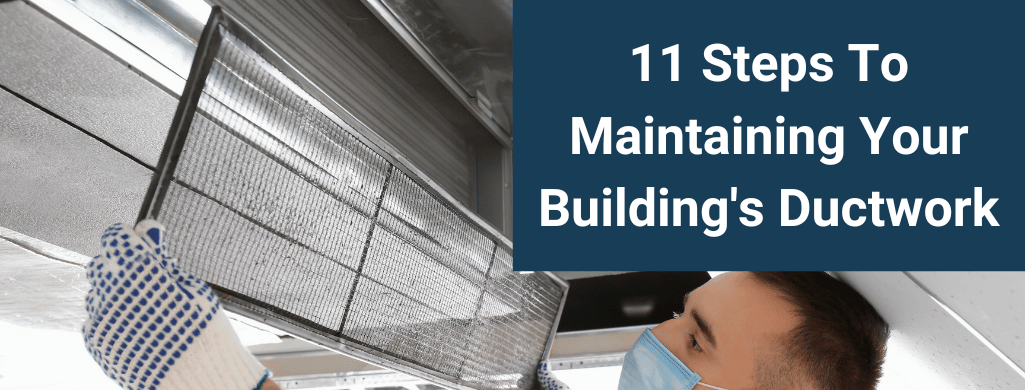Commercial Air Duct Maintenance Checklist
When performing air duct maintenance, it is best to approach with a clear process. Our HVAC technicians and the team at PROAC have a clear approach to cleaning ductwork, performing air duct maintenance, and repairing commercial ductwork. Below is a checklist you can use to perform regular checkups on your HVAC ductwork. Or, you can hire our trained professionals at PROAC to clean, maintain and repair your ductwork.
It is important to note while this is a checklist for maintaining your building’s air ducts, they are only a section of a larger system. Your building ductwork maintenance is only effective in managing a small part of your entire HVAC system. Make sure to clean, maintain, and repair your entire HVAC system. From the cooling towers outside to the air handler, the filters, and the mechanical room, the HVAC system is the circulatory system that keeps your building alive and healthy.
1. Clean Your Duct Work
A great place to start is cleaning your ducts. Remove the dust that builds up naturally, clean any grime that has developed and make sure the surfaces of your ductwork are clear of all dust, particulates, or dirt. While cleaning you can do all of the following maintenance checks for ductwork.
2. Check For Duct Work Damage, Dents & Leaks
As you clean your ductwork, check the entire system for any damage. Dents in your ductwork can lead to cracks which can lead to leaks. Typically dents and damage are recurring. In an industrial building, a piece of machinery may regularly bump your ductwork causing damage. Damage to your HVAC system’s ductwork can lead to your system working poorly.
3. Check Air Duct Connections Are Sealed
When the seal between duct panels breaks, it can lead to the ductwork and HVAC system leaking air and being ineffective. The structural integrity can be compromised, and there is a risk of the ductwork continuing to fall apart.
4. Check For Excess Dirt Build Up In Ducts
If there is an abnormal amount of dirt build up in your ductwork, it can indicate rodents or pests from outside have accessed ductwork and the HVAC system. If an animal has accessed your commercial building’s ductwork, that means it is no longer sealed, and it is likely a large amount of damage has been caused by the animal and pests.
5. Check For Rust Development In Duct Work
If there is rust in your ductwork, it shows the metal is exposed to moisture. The metal should be sealed and repaired if it is rusting. Moisture and water build up can lead to larger issues within your ductwork.
6. Check For Moisture Build Up & Condensation In Your Ducts
Moisture build up, water pooling, or high levels of condensation in your ductwork can indicate leaks and functionality issues with your HVAC system. A broken air handler can be a common source of water issues in an HVAC system. Finding the source of the moisture buildup and fixing it is vital to your HVAC system’s and your employees’ health.
7. Check For Mold Growth In Your Ducts
Mold growth within your ductwork is a direct result of moisture buildup, HVAC mold can cause a myriad of issues like problems with your air quality, rust in your ductwork, and mold spread throughout your building.
Remove the mold from your ductwork to prevent these problems from arising. It is also vital to test your business’s air quality. Make sure you remove the source or the cause of the moisture buildup. Mold remediation is important, but preventing your building from having mold problems is vital to its longevity.
8. Check Fire Dampener Accessibility & Functionality
A fire dampener is located with your building’s ductwork and serves to block the airflow when temperatures reach a certain level. This is to stop airflow since the constant feeding of air will allow fires to burn faster and more effectively. Items to check with your fire dampener:
- Check your fire dampener is not clogged or caught with dirt or debris.
- Make sure your fire dampener has not been activated. If it has been activated, further diagnosis is needed to determine if it is faulty or if high temperatures have been reached in the HVAC system as a result of larger issues.
- Make sure the fire dampener is accessible.
9. Check Duct Access Doors
Duct access doors can be an area where damage or dirt buildup occurs, especially if they are accessed a lot by untrained team members. Make sure the access door fully closes.
10. Check Air Duct Grilles
Make sure ductwork registers and grilles where the air exits the HVAC system, or the return path intake grilles that take air into the system are clean and clear. These narrow slits can quickly be covered and blocked. Restricting the system’s airflow makes your HVAC work harder with poor results.
11. Check Ductwork Return Path
Is the return path clear and unobstructed? The return air duct path must be clear in order for the HVAC system to work correctly. If the air supply is unable to reach the primary HVAC system, it will not function effectively.
Contact PROAC To Maintain & Repair Your HVAC System
At PROAC, we provide professional HVAC maintenance, HVAC cleaning and HVAC repair. When performing these services, we go through the above checklist and more to help your commercial building’s HVAC system last longer. Contact us for a free quote.

